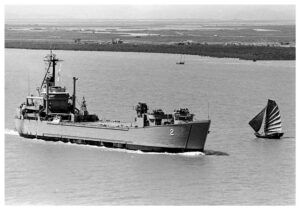The United States Navy has named seven ships for Boston, six for Baltimore, and four each for Chicago and Los Angeles. It named only one for a Michigan county: the USS Washtenaw County, which went on to become the most highly decorated vessel of the Vietnam War.

A model by the late Bill Price at the Washtenaw County Building. Photo: J. Adrian Wylie
Built in Sturgeon Bay, Wisconsin, it was commissioned in New Orleans in 1953 as the USS LST-1166. LST stands for “landing ship, tank.” With a shallow draft, flat bottom, and bow ramp, the tanks, trucks, and other vehicles it carried could roll straight off the ship onto a beach. In 1955, the navy renamed all its LSTs after counties, and 1166 became the USS Washtenaw County.
Why Washtenaw was singled out among Michigan’s eighty-three counties is a mystery. In a 2011 documentary for Ann Arbor’s Community Television Network (CTN), attorney and Vietnam veteran Elmer White speculated that it may have been suggested by one of the thousands of naval officers who had graduated from the University of Michigan.
—
After initial tours in the Atlantic and Mediterranean, the Washtenaw County was transferred to the Pacific fleet in 1958 and deployed to East Asia. From its home port in Yokosuka, Japan, it visited the Philippines, Taiwan, Hong Kong, Thailand, Singapore, and South Korea. But its most extended role was in Vietnam, starting in 1962 as the U.S. expanded the number of military personnel advising South Vietnamese troops, and increasing after American soldiers were committed to combat. A photo on navsource.org shows it “offloading vehicles onto a pontoon causeway, off Chu Lai, South Vietnam during the initial landing in May 1965.”
As a member of the “brown water navy,” the Washtenaw County sailed in the channels of the Mekong Delta and the coastal waters of Vietnam throughout the war. It delivered combat troops, equipment, ammunition, and rations, and took the wounded aboard.
After the signing of the Paris Peace Accords in January 1973, the Washtenaw County was converted to a “special device minesweeper” and assigned the mission of verifying the removal of mines from North Vietnam’s Haiphong harbor. The hull was filled with foam below the waterline, and a bare-bones, all-volunteer crew of seven assembled. In April 1973, it was the first American ship to enter the harbor in more than a decade. It made six passes that day and was scheduled to make another six the following day, but due to problems at the negotiating table, minesweeping operations were halted. The sweeps were finally completed without incident on June 20 and the harbor reopened.
One of the last American vessels to leave Vietnam, the USS Washtenaw County departed as the most decorated ship of the war, with two Presidential Unit Citations, sixteen battle stars, and a number of additional awards for service. It returned to Yokosuka, where it berthed on July 30, 1973. It was deactivated in August, and its name struck from the Naval Vessel Register.
—

The USS Washtenaw County underway in Haiphong harbor, North Vietnam, in June 1973. With a bare-bones volunteer crew, it verified that all U.S. mines in the shipping channel had been cleared. | Courtesy U.S. Naval History and Heritage Command
The former Washtenaw County/LST-1166 is still afloat, but to the chagrin of its former sailors, it’s just a shell of its former self. Sold for civilian use in 1973, the ship was resold in 1980 and converted to a “roll-on/roll-off” vehicle transport. But if it ever served in that role, it wasn’t for long: According to navsource.org, it “[a]rrived in tow at Portland, OR, in October 1980, with mechanical troubles. Still there on January 19, 1984, when [the] engine room flooded.”
A nonprofit there hoped to restore the ship as the centerpiece of a museum about the navy’s amphibious forces but couldn’t muster the needed resources. Since 2003, it has been moored in a backwater of the Columbia River near Rainier, Oregon. The ship is now ravaged beyond repair, due primarily to vandalism.
“It has saddened me because apparently there are no other LST ships of that class that are available for restoration,” former crewman Tom Osmond recalled in the CTN documentary. Even in its namesake county, the Washtenaw County was in danger of being forgotten after a small display in its memory was dismantled and put into storage.
That changed when White discovered the artifacts among other castoff items in a county warehouse. In 2009, White, Osmund, George Perrault, and other members of the Washtenaw County chapter of the Vietnam Veterans of America organized “Operation Harbor” to create a new exhibit.
The result is now prominently displayed in the lobby of the Washtenaw County Building at 200 N. Main. Highlights include a model of the ship built by the late Bill Prince, the ship’s wheel, and a 400-pound brass bell that according to Perrault needed a lot of elbow grease to get shipshape. At its dedication in 2011, White recalls, “vets from all around the country attended.”
I read this with interest and fond recall. Serving as the Director of the Washtenaw County Department of Veterans Affairs during the restoration efforts, I was fortunate to be able to work with a number of dedicated local veterans to guarantee that the USS Washtenaw County and the remaining artifacts were appropriately recognized and permanently placed on display in the main lobby area of the Washtenaw County Building-200 N. Main Street in Ann Arbor. Worth noting, one of the veterans mentioned in the piece, Elmer White, served on the Washtenaw County Historic District Commission at the time. His position, influence and commitment to the project was critical as he championed the cause stressing the fact that the artifacts of the USS Washtenaw County were designated as Washtenaw County’s first Historic District (dedicated in 1978) and should be so honored in an exhibit where the citizens of Washtenaw County could view, learn and remember. Thank you for the memory.